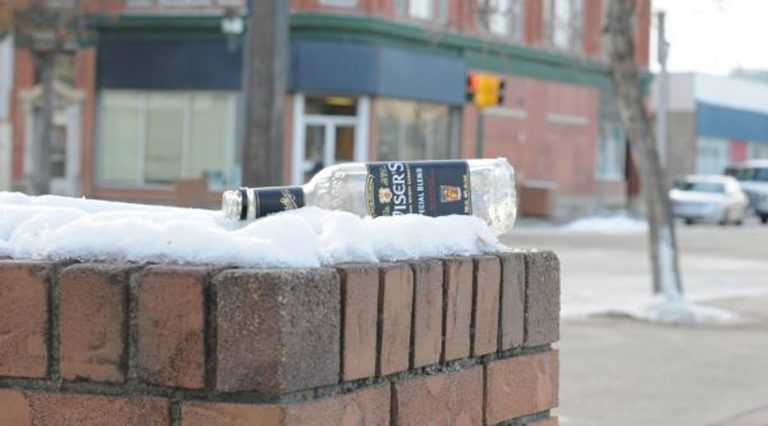
Saskatchewan was one of a handful of provinces and territories to avoid getting a failing grade in a pair of recent reports from the Canadian Alcohol Policy Evaluation (CAPE) project.
Researchers from the University of Victoria’s Canadian Institute for Substance Use Research (CISUR) and the Centre for Addictions and Mental Health (CAMH) in Toronto officially released the CAPE reports on Thursday. The reports compare provincial and federal alcohol policies in 11 different categories against the current best practices.
Saskatchewan earned a ‘D’ grade from the project, taking top marks in the country for its liquor law enforcement policies, but struggling in other areas such as health messaging and control systems. The report also includes more than 50 recommendations, some targeting individual provincial governments and others targeting the country as a whole.
CISUR director Tim Stockwell said Saskatchewan is doing plenty of things right, however there are also some significant concerns.
“Saskatchewan is doing some fantastic things (and) they’re falling down on lots of others,” Stockwell explained. “It doesn’t fail. I mean, we’ve got five jurisdictions with failing grades, and Saskatchewan is at least not getting a D-.”
Among the main concerns is how bars and clubs interact with potential customers on social media. Stockwell said nearly all Canadian governments have struggled to keep an eye on the Internet the same way they monitor traditional media. He’s worried that many of the rules outlined in the Canadian Radio-television and Telecommunications Commission (CRTC) are being blatantly disregarded online.
“Here’s a whole area that most of Canada falls down on, nearly everywhere,” Stockwell said. “In particular, (they fail at) having independent monitoring of the new social media platforms that bars and clubs are using to promote alcohol and drinking excessively. Hardly anybody is watching those. They’re looking at the traditional print and electronic media, but not the new digital media, and it’s a wild west.”

Another major recommendation was for like Saskatchewan to discontinue plans to privatize retail alcohol sales. In 2016, the provincial government privatized 39 existing government owned liquor stores, and awarded permits for 11 new ones.
Stockwell said the costs significantly outweigh any benefits and he urged provinces like Saskatchewan to give the issue a second look.
“It’s a weakening of the public ownership of the distribution and sale of alcohol,” he said. “That’s seen as being old fashioned. I think what we need is to modernize the whole system of regulating alcohol in the public interest, taking account of convenience and affordability, but within reason and putting boundaries around it.”
Liquor store hours and the need for updated provincial and national alcohol strategies were to other major issues raised in the reports. Like Stockwell, CAMH emeritus scientist Norman Geisbrecht said Saskatchewan should back away from privatizing liquor stores. He also said the province should look at reducing the hours liquor stores can stay open, something the City of Prince Albert has tried to do in the past with no success.
“If you have longer hours you’re likely to have more harm from alcohol,” Geisbrecht explained. “Both those things I think are things that could be addressed by looking at what some of the other provinces are doing, and would be helpful in terms of the short-term or long-term terms reduction of the harm from alcohol.”
There were some positives in the report. Both Stockwell and Geisbrecht said other province’s should follow Saskatchewan’s lead and raise their legal drinking age to 19, or even higher. They also said Saskatchewan does a good job of pricing alcohol at appropriate levels, although there are a few minor improvements that could be made.
They also praised Saskatchewan for its police inspection programs, and for cracking down on impaired driving.
To get better, both experts suggested Saskatchewan look around the country to see what other policies are proving successful.
While no province scored higher than a C, they said nearly every province is doing one or two things right. In fact, if every best practice policy currently in use somewhere in Canada was implemented nation-wide, every province would have an almost perfect rating.
“All the provinces have some strengths and all the territories have some strengths,” Geisbrecht said. “I think that the basic message is that provinces and territories need to look at each other, look at what their neighbours are doing better, and learn from them.”
“There are like 250 different data elements, practices and strategies we look for in each jurisdiction and we found that 87 per cent of those were being done by somebody somewhere, so nearly all of this is already being done by some jurisdiction somewhere in Canada,” Stockwell added. “If that was done consistently, Canada would have got an ‘A’ grade.”
Ontario received the highest grade out of every province with a ‘C’, although data used in the reports was from 2017, so it did not include Ontario premier Doug Ford’s recent campaign for $1 beer. British Columbia earned the second highest grade with a D+. Alberta, Manitoba, Nova Scotia and Nunanut all earned ‘D’ grades along with Saskatchewan. New Brunswick, Prince Edward Island, Newfoundland, Yukon and the Northwest Territories all received failing grades, as did the federal government.
